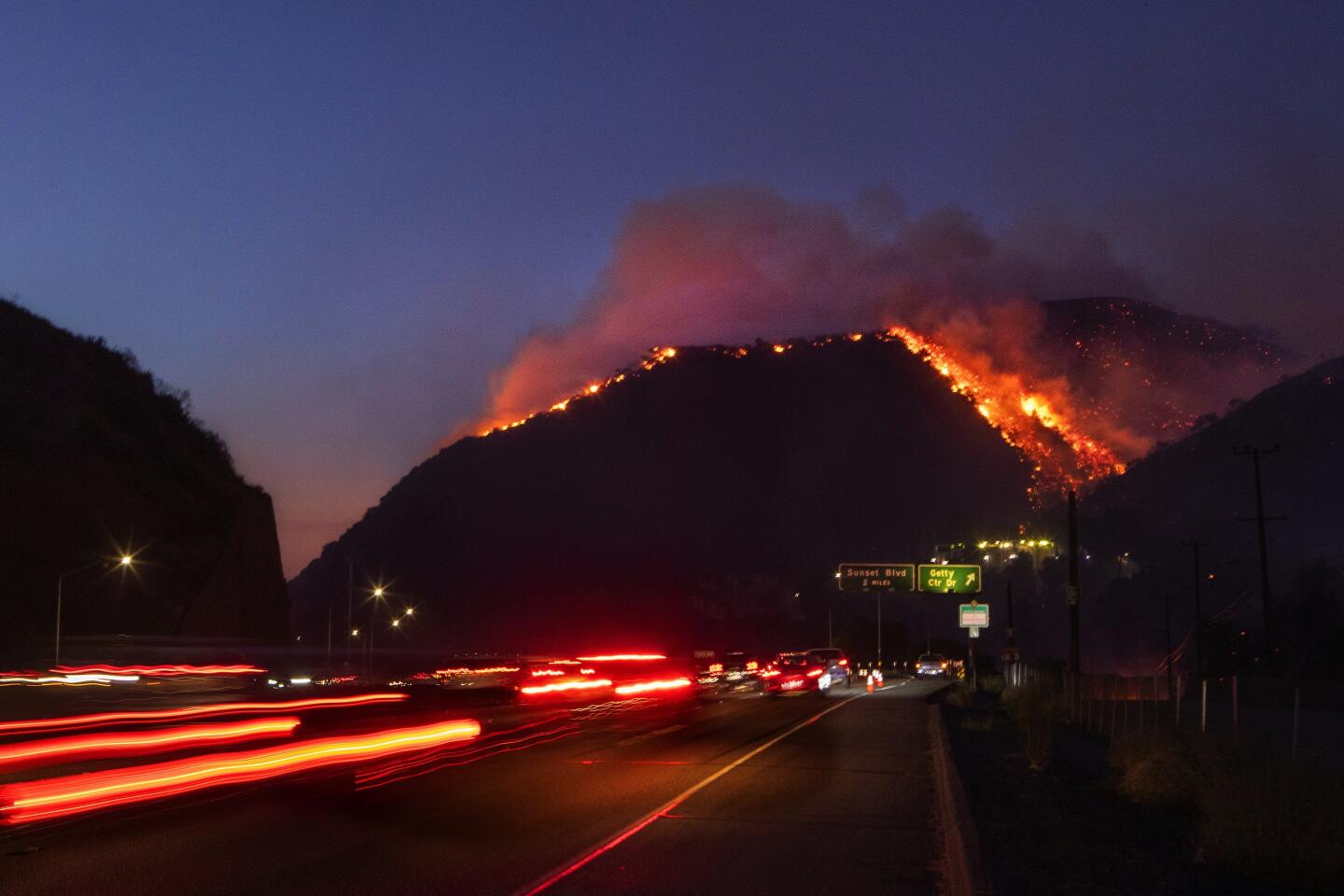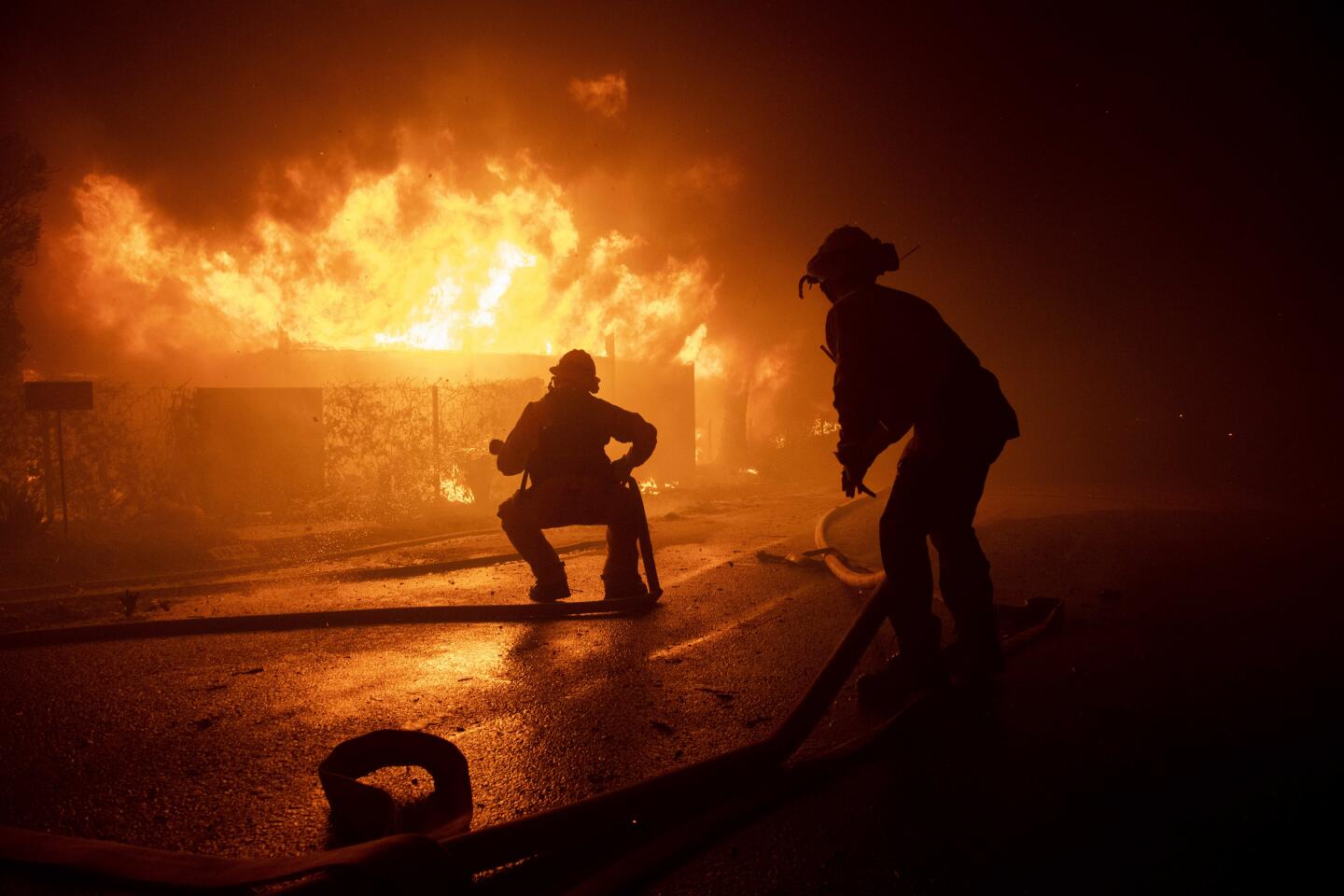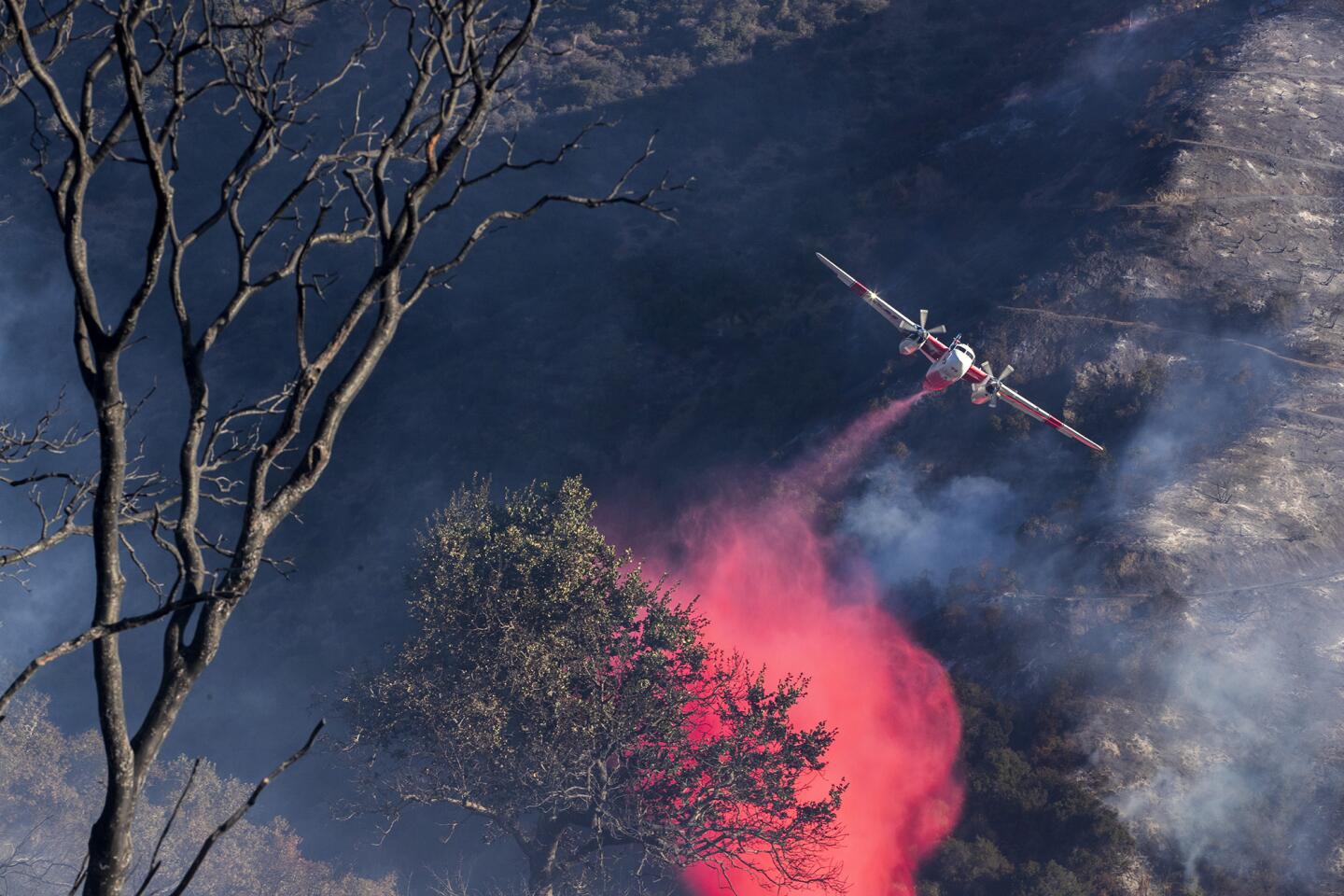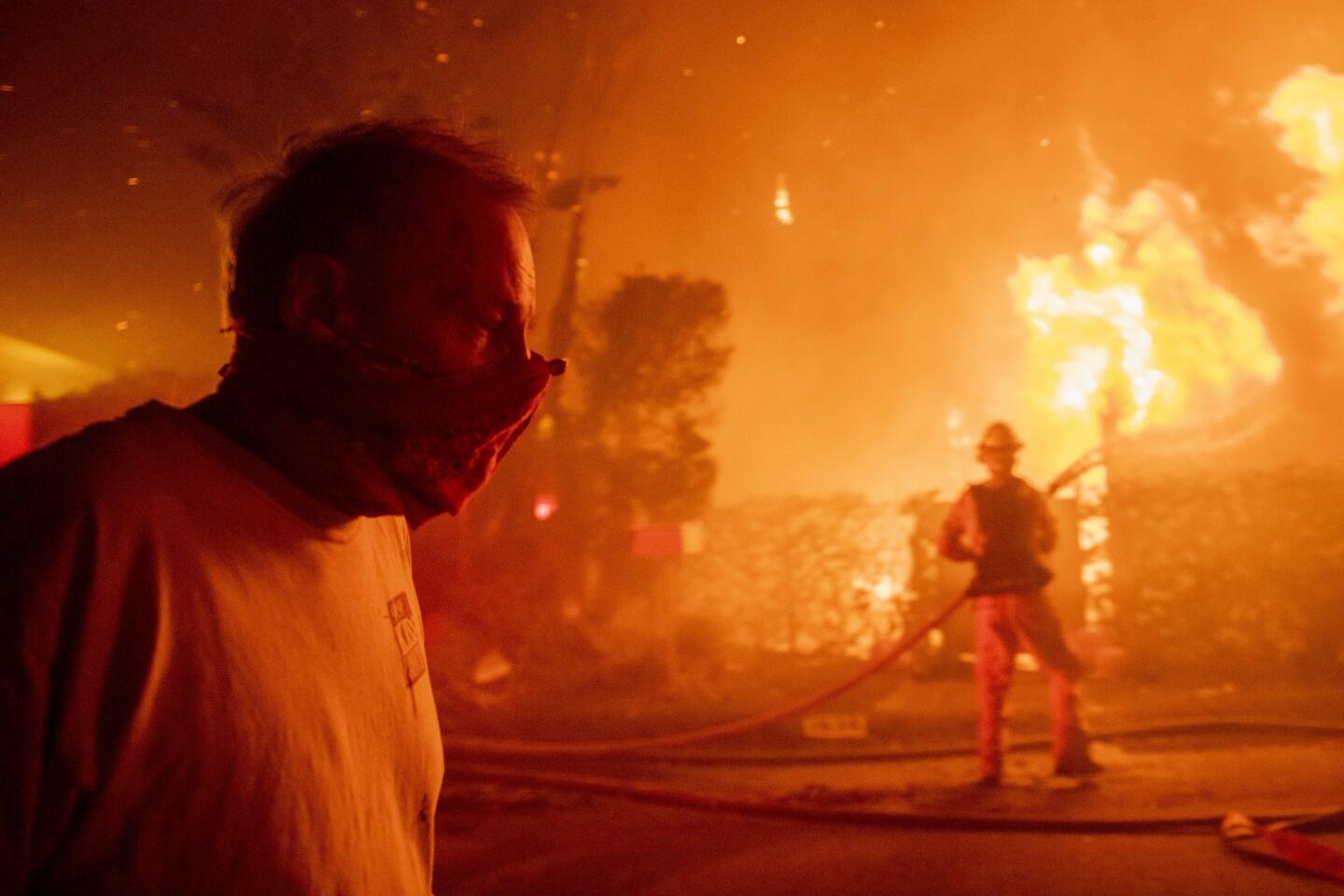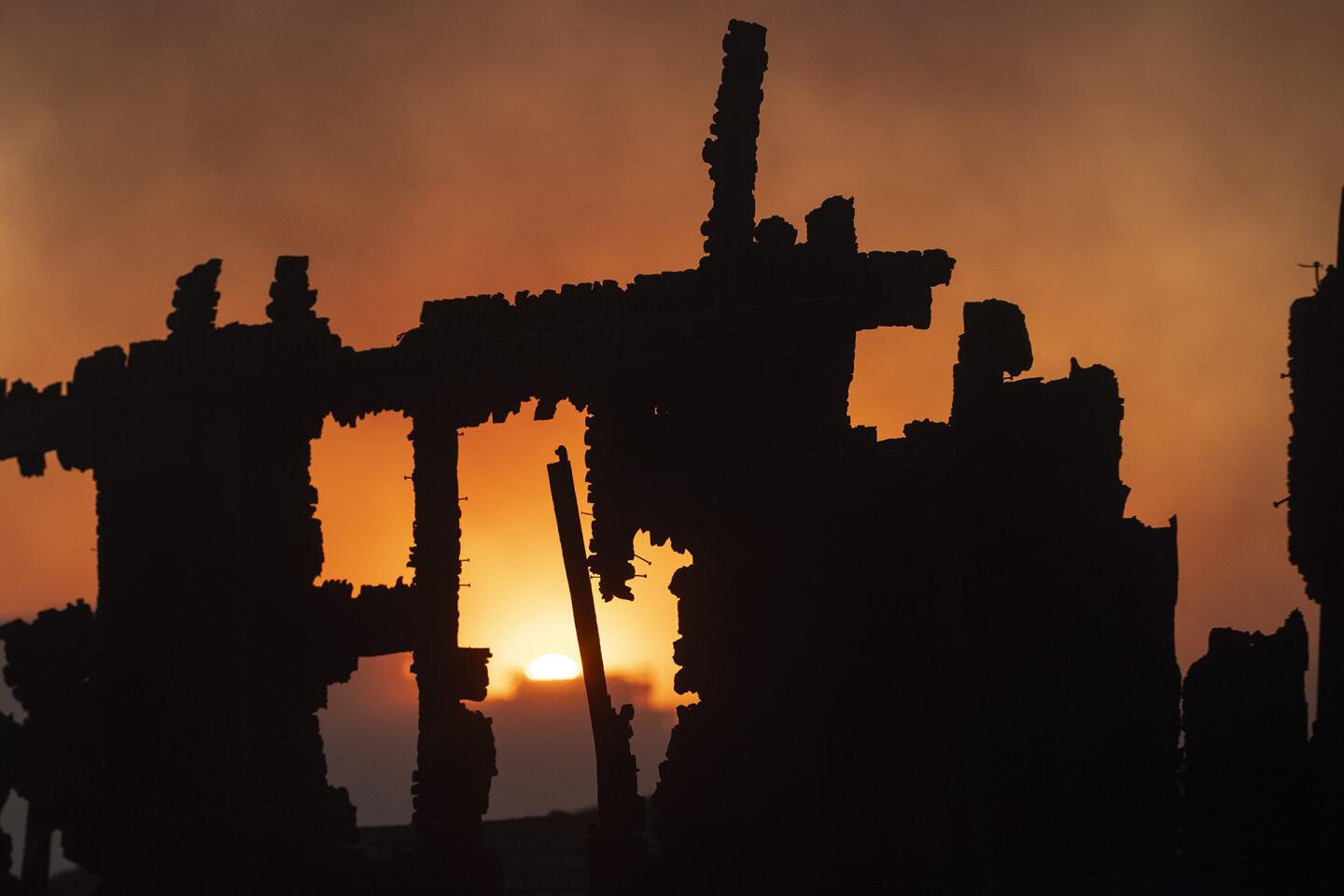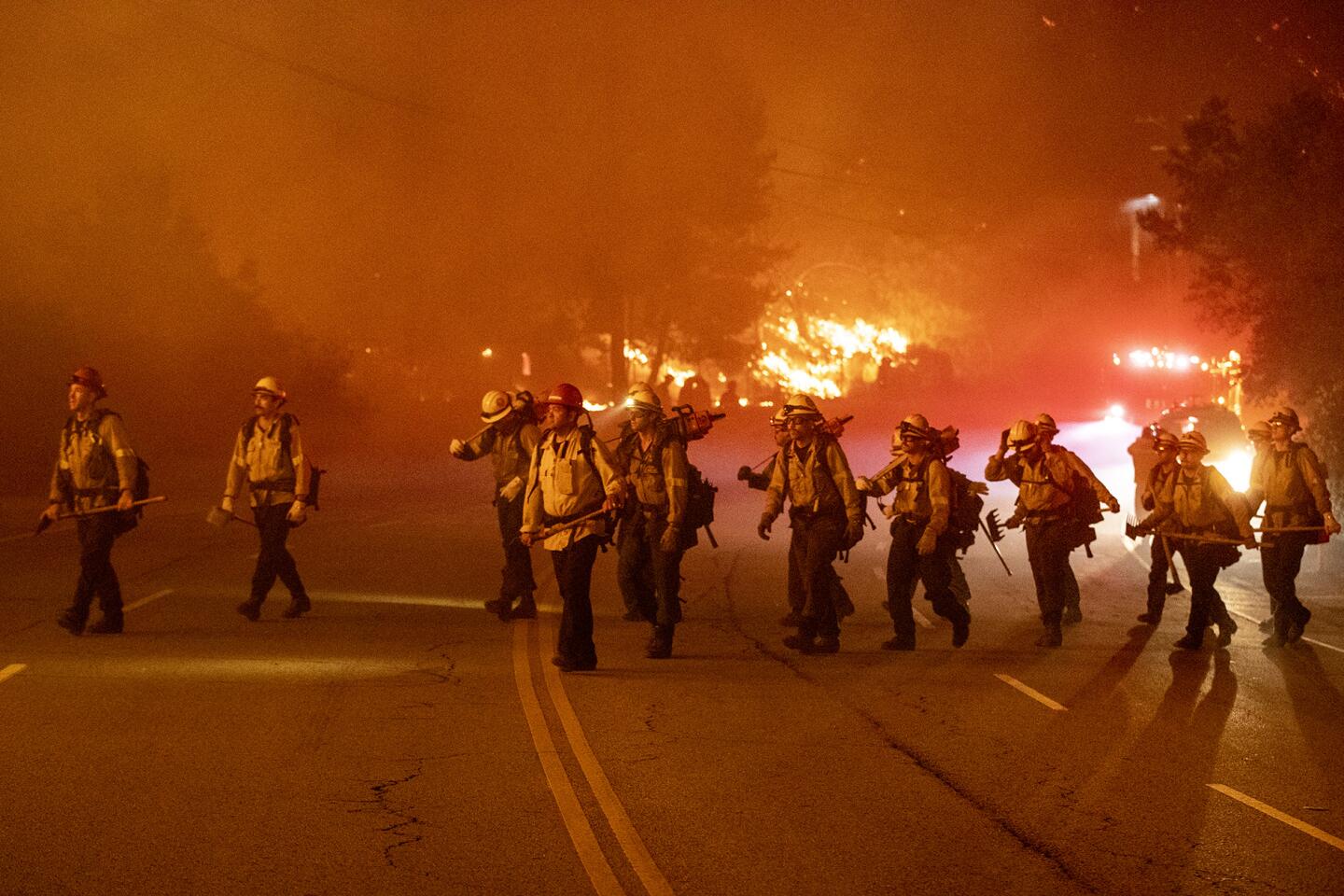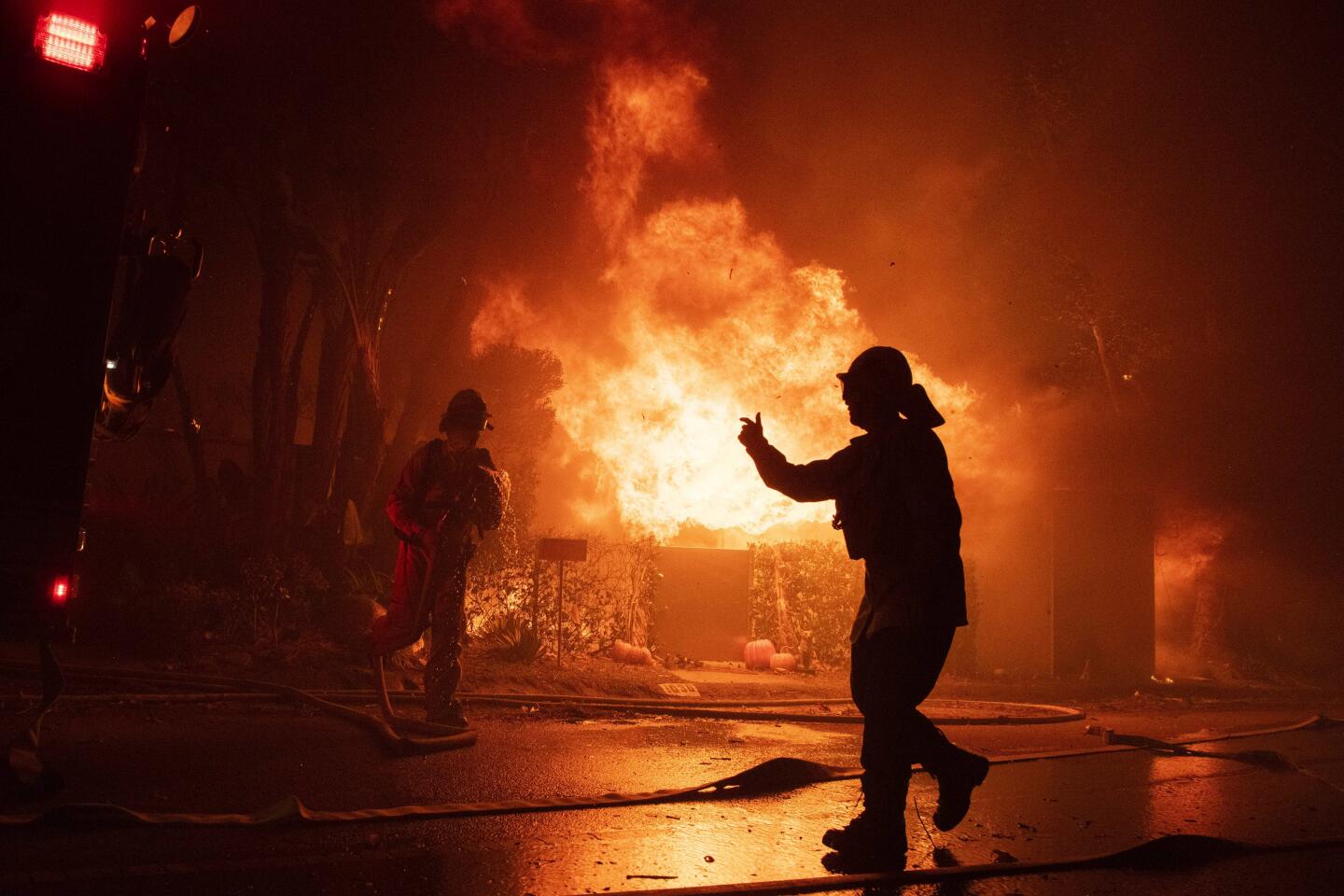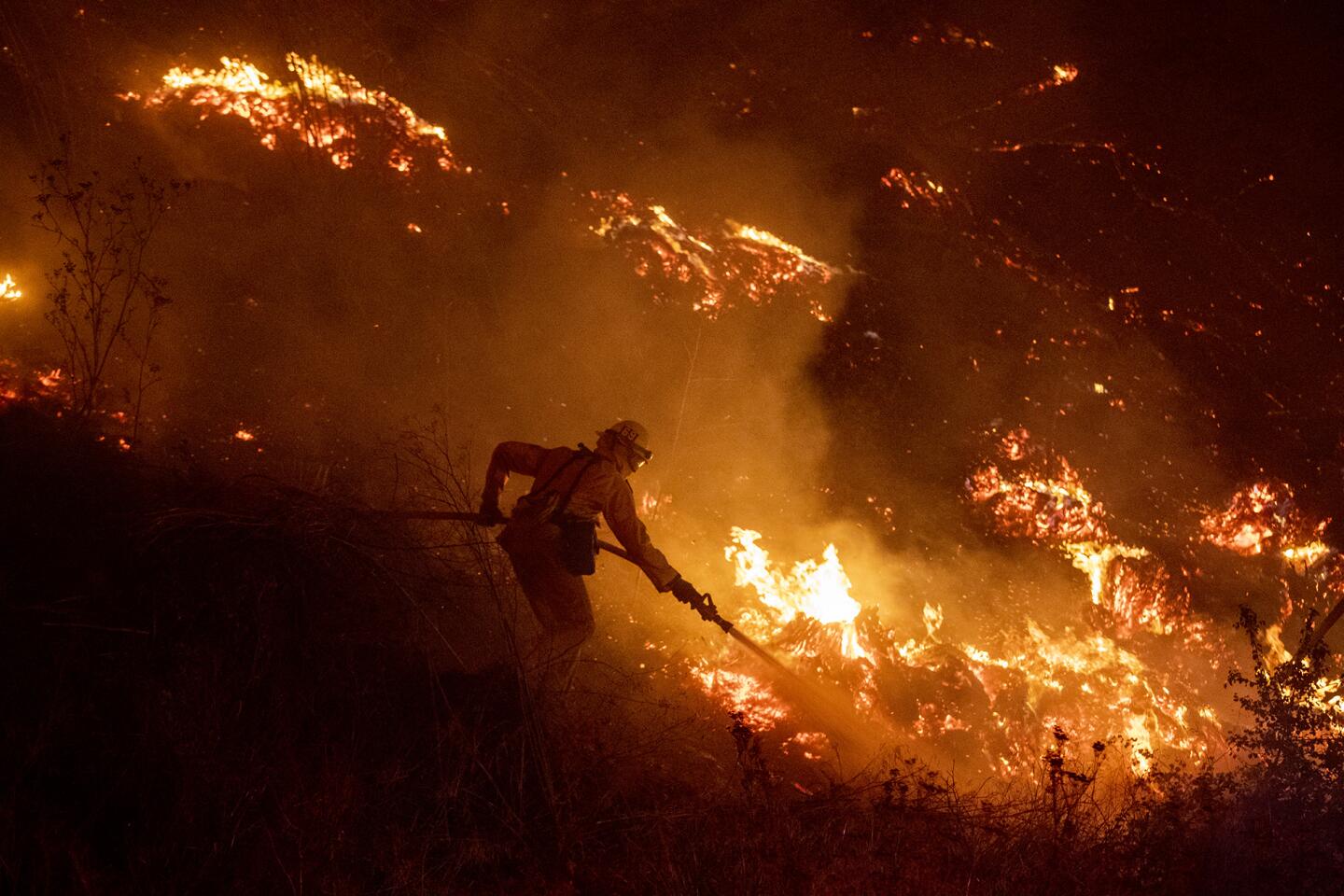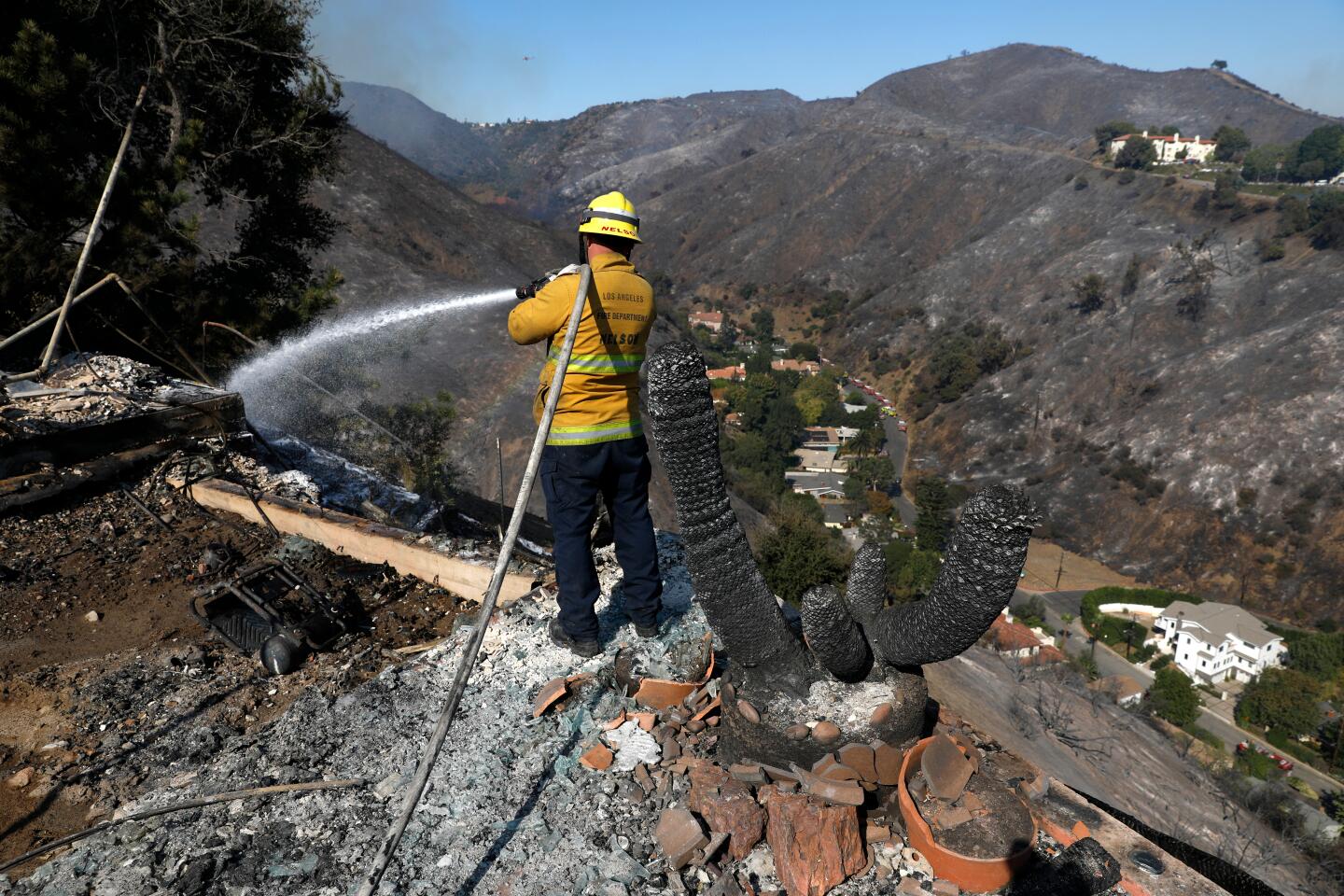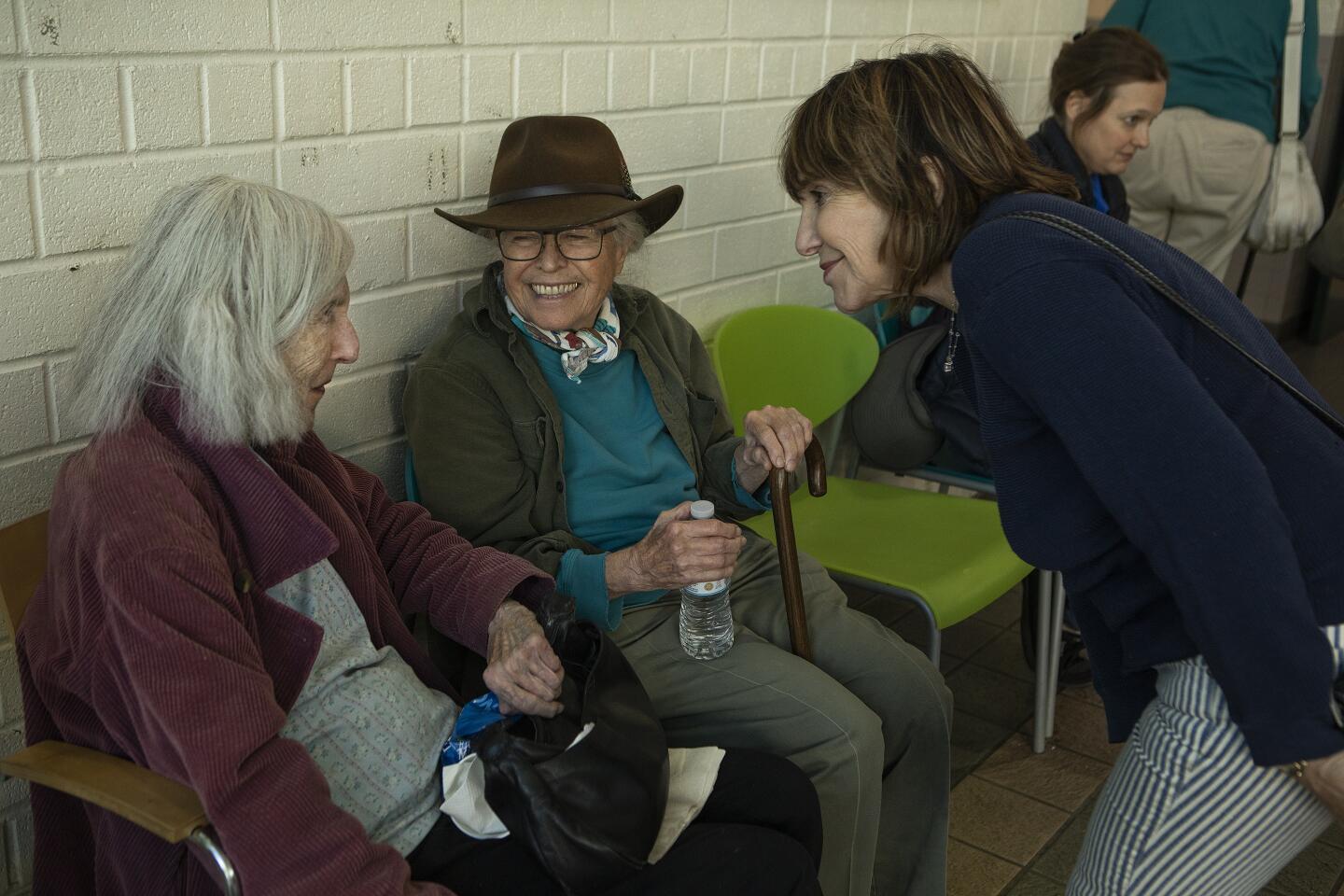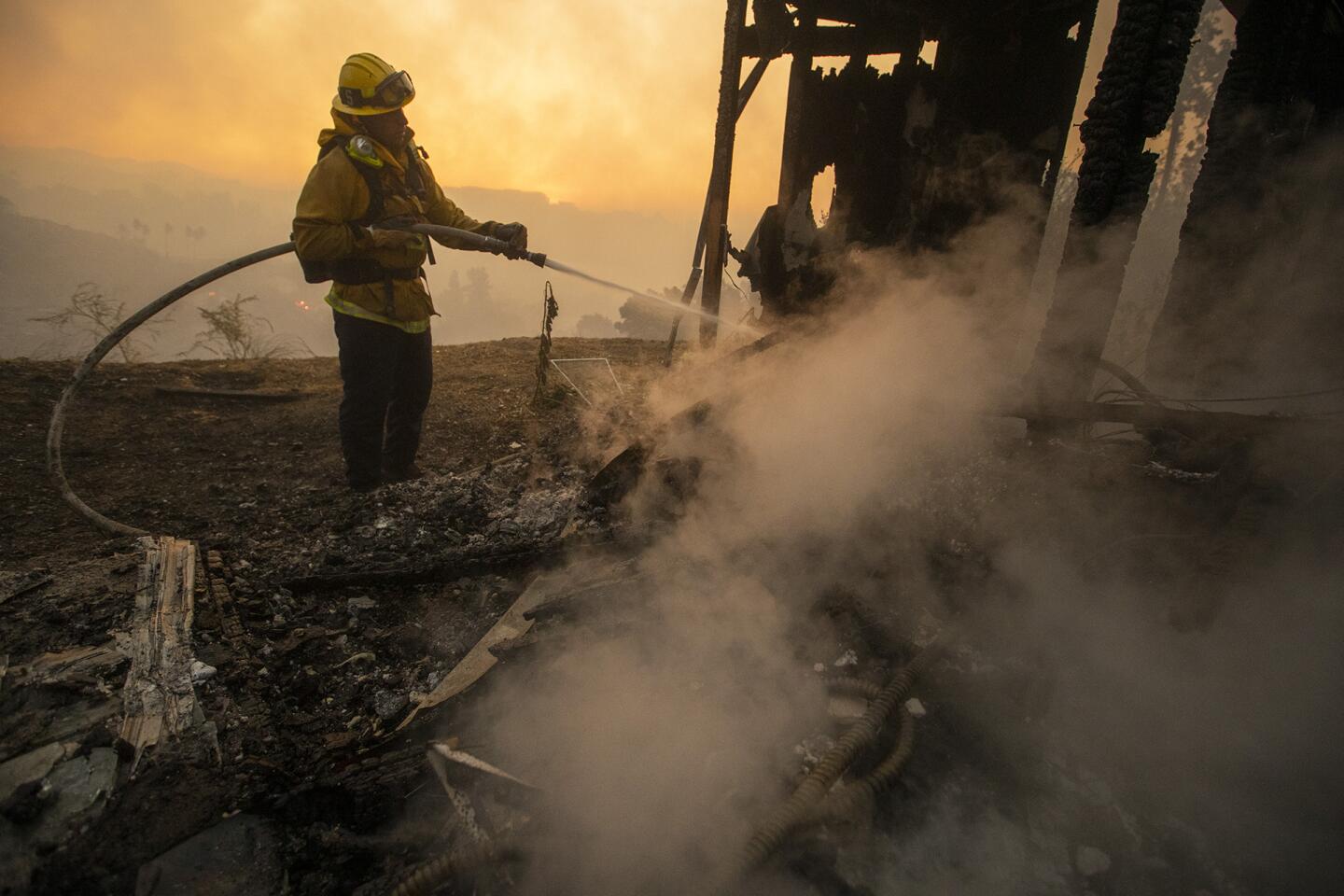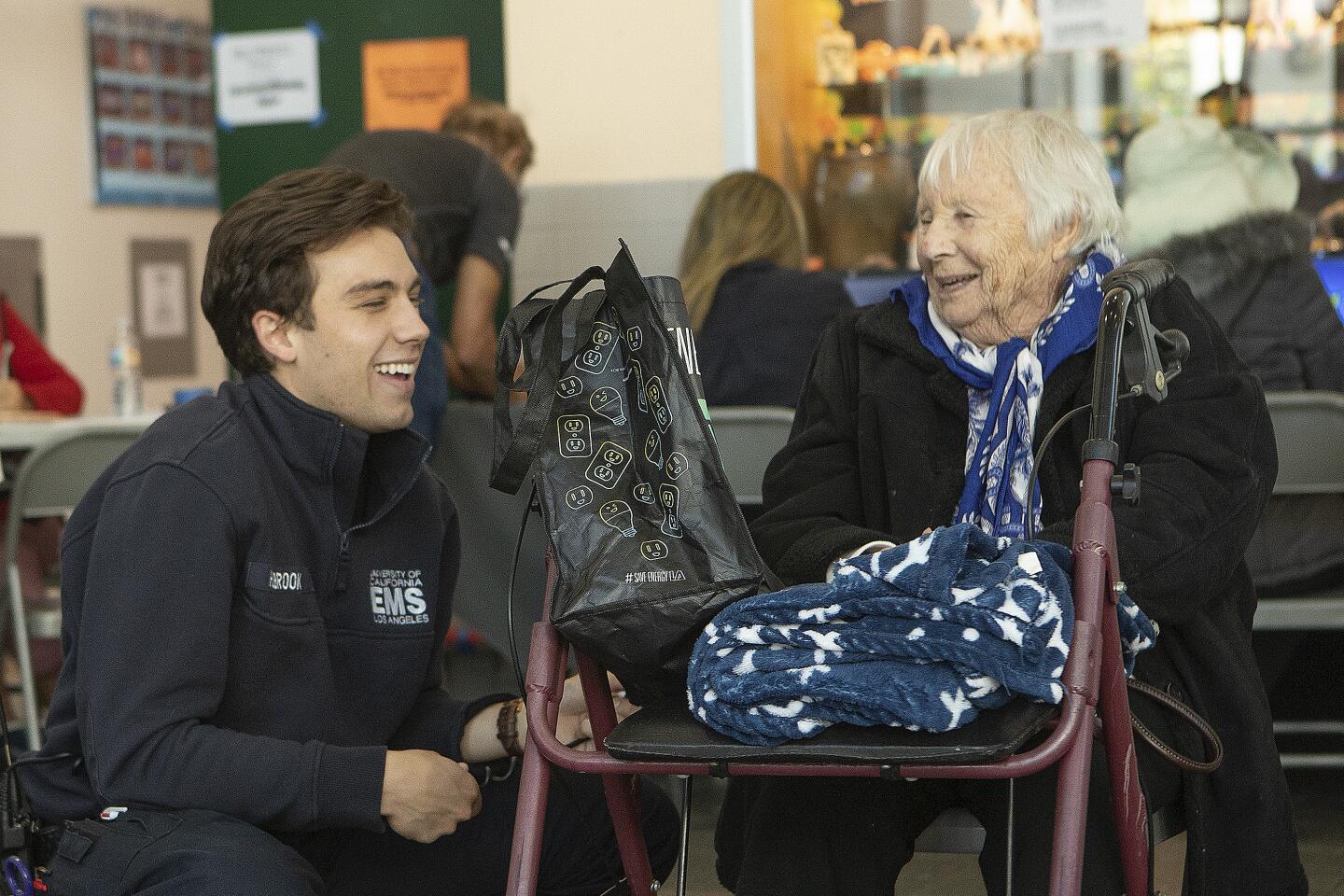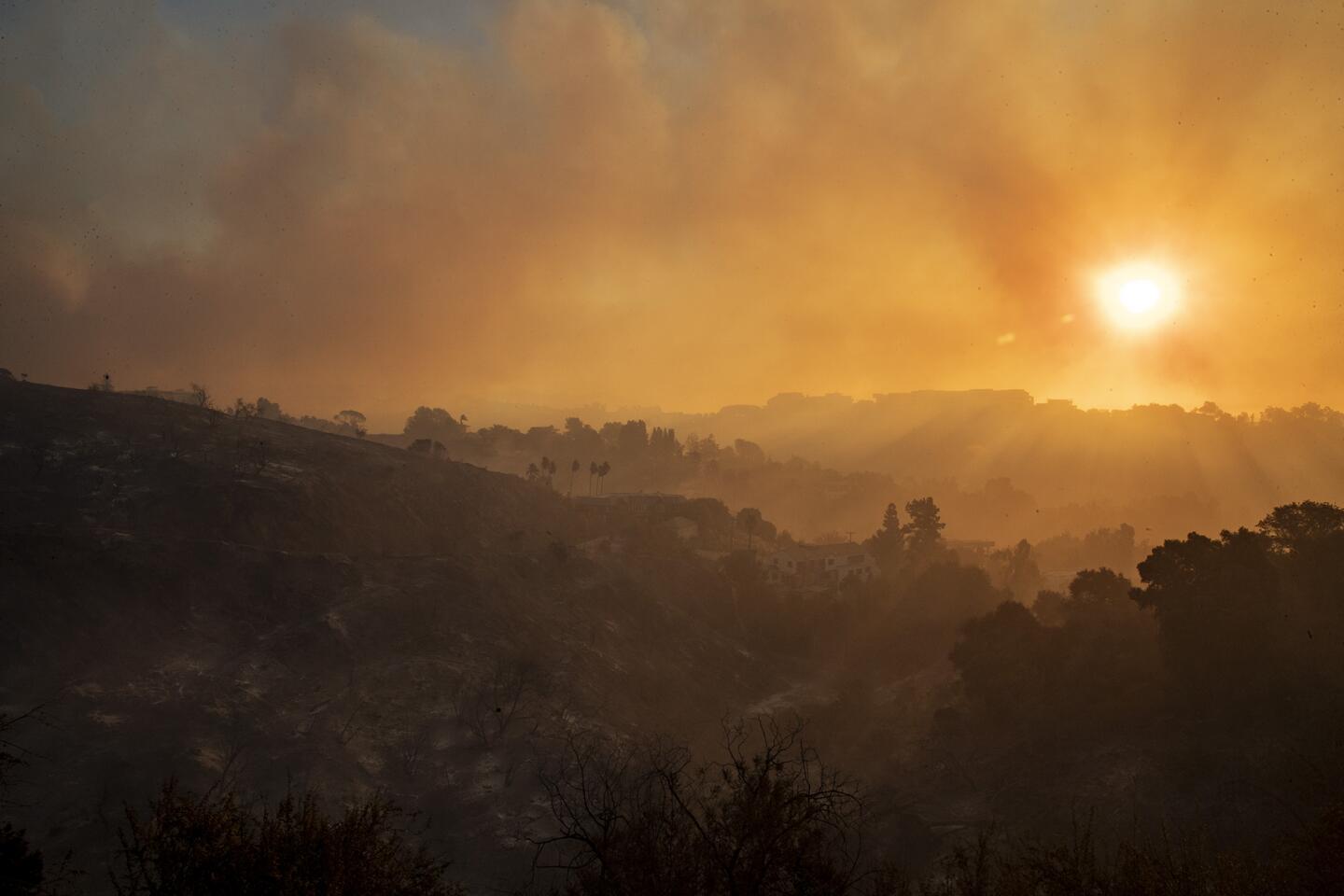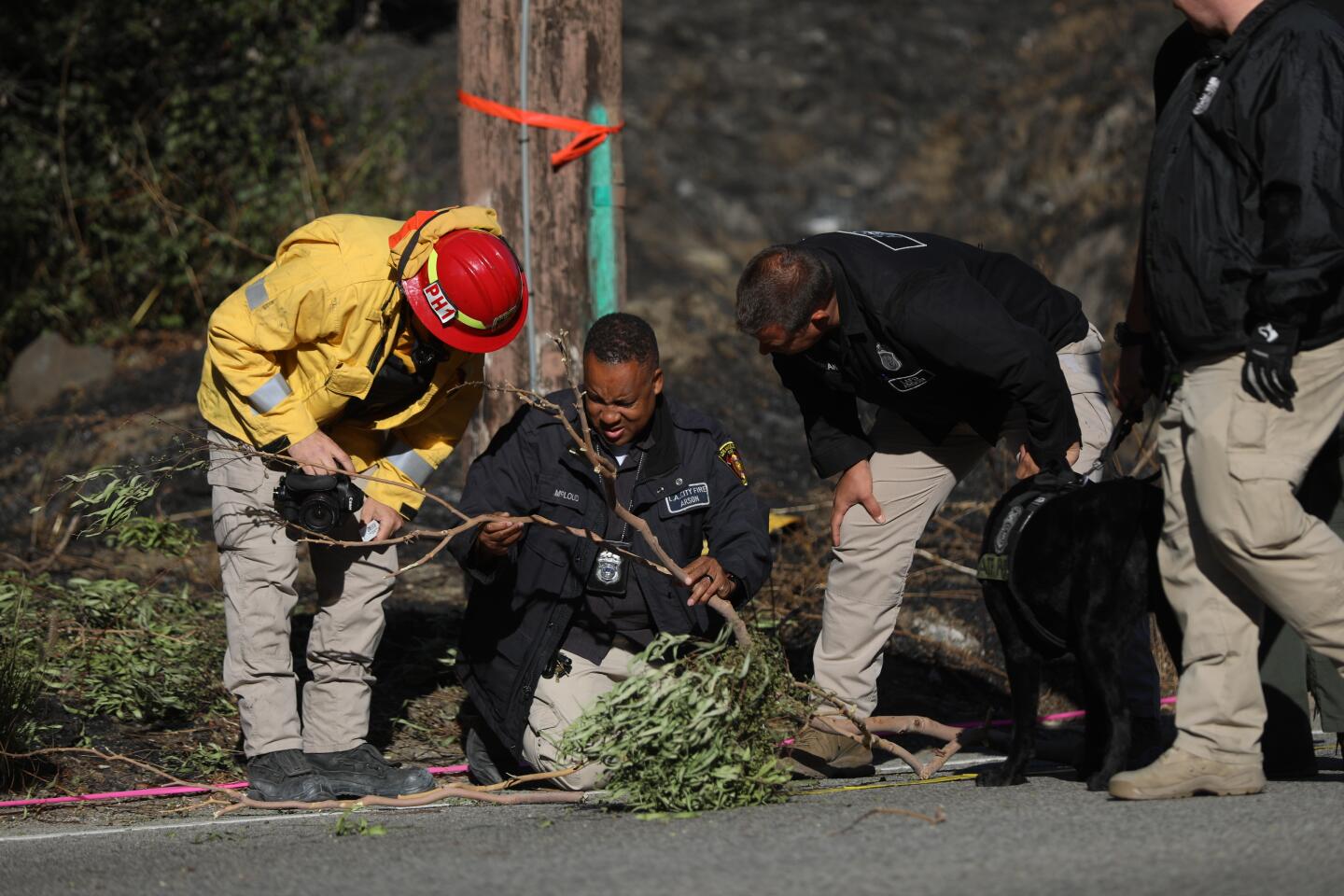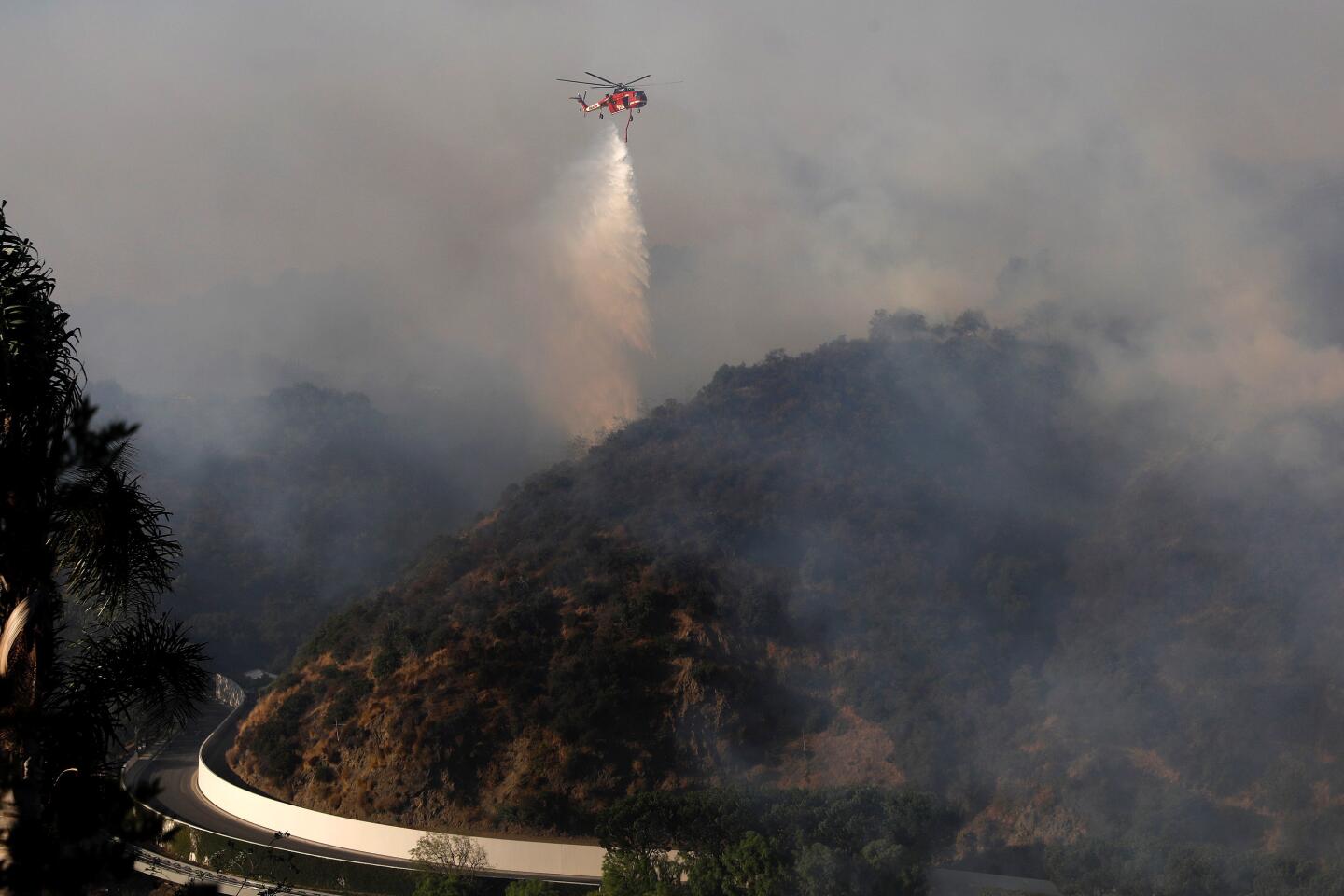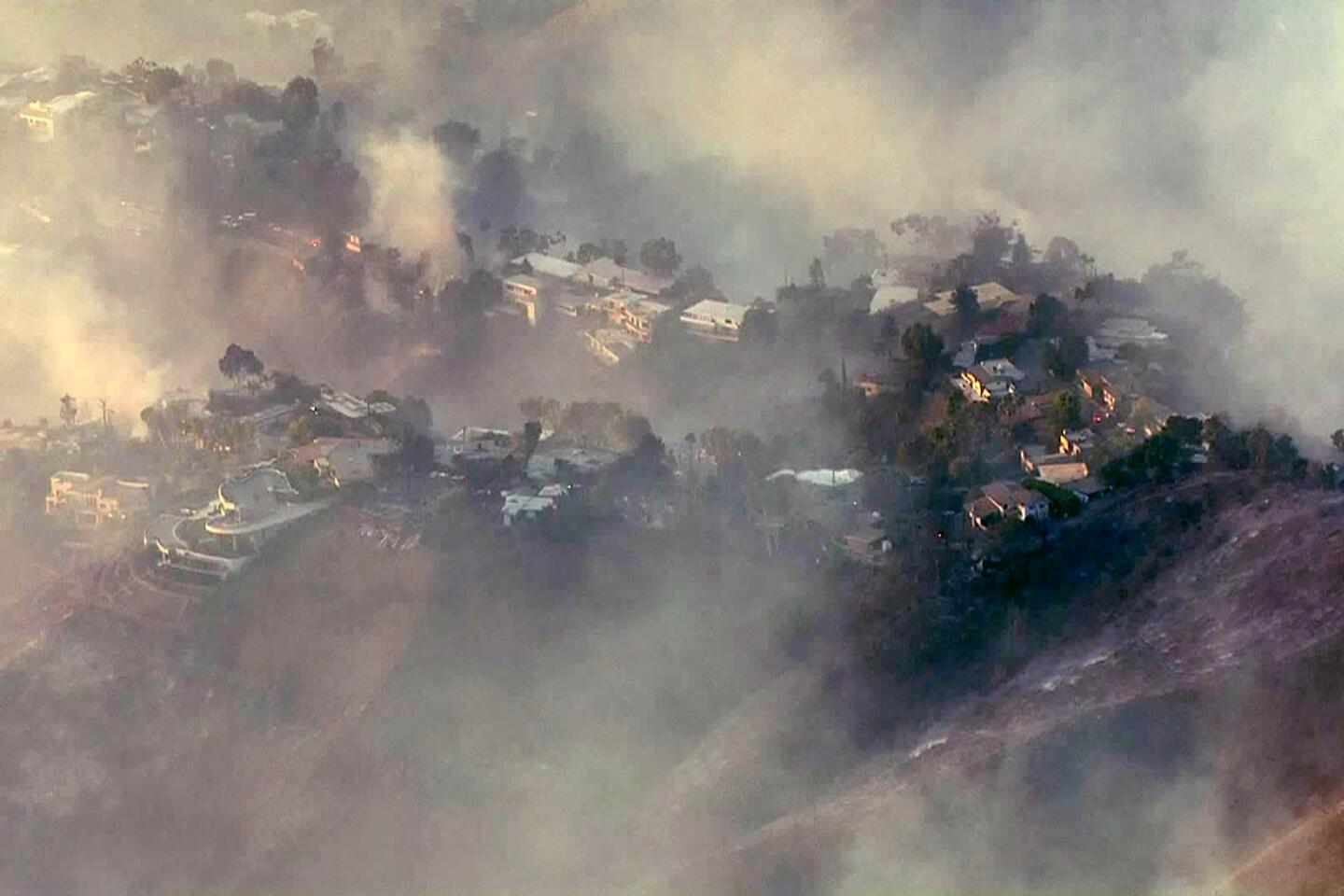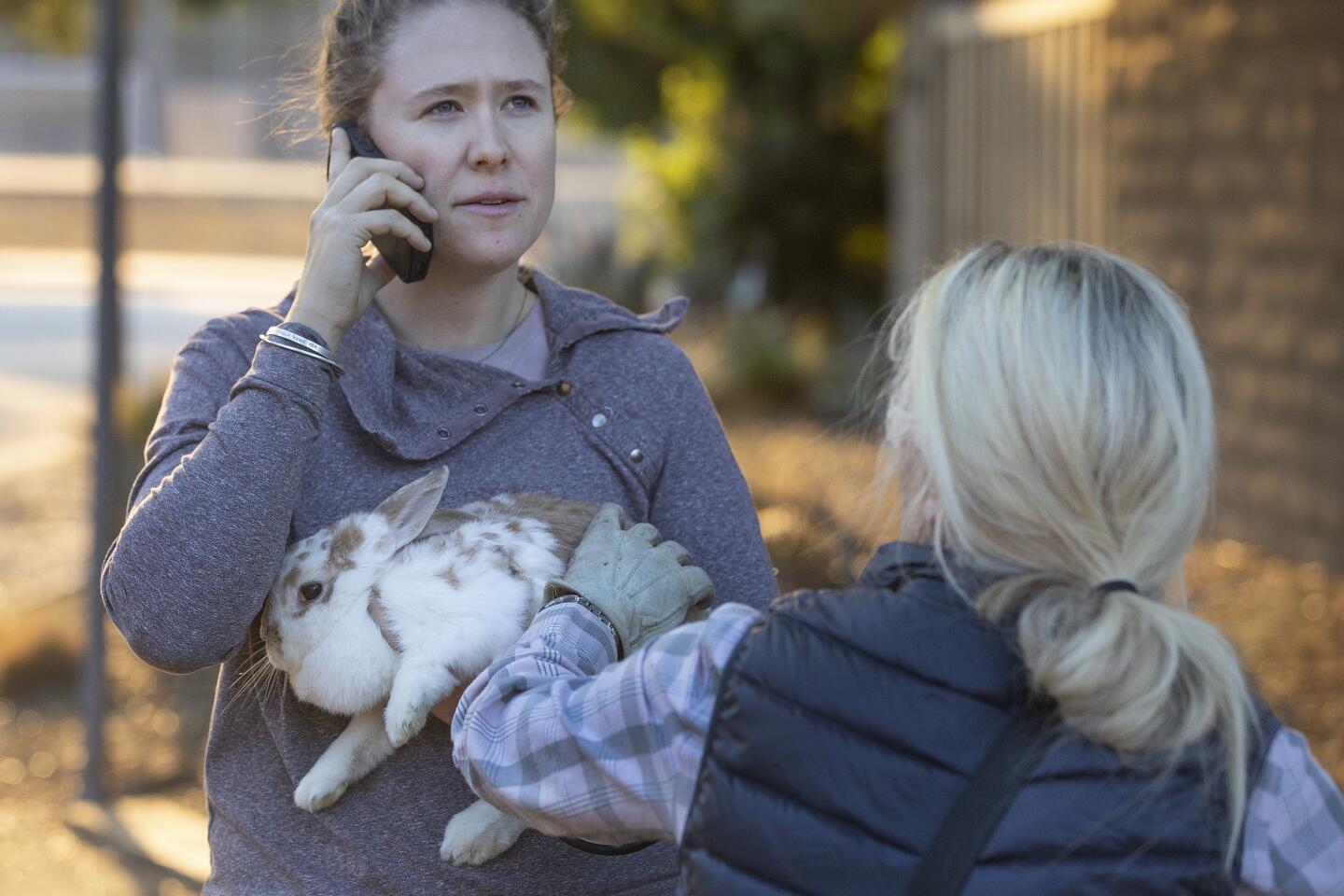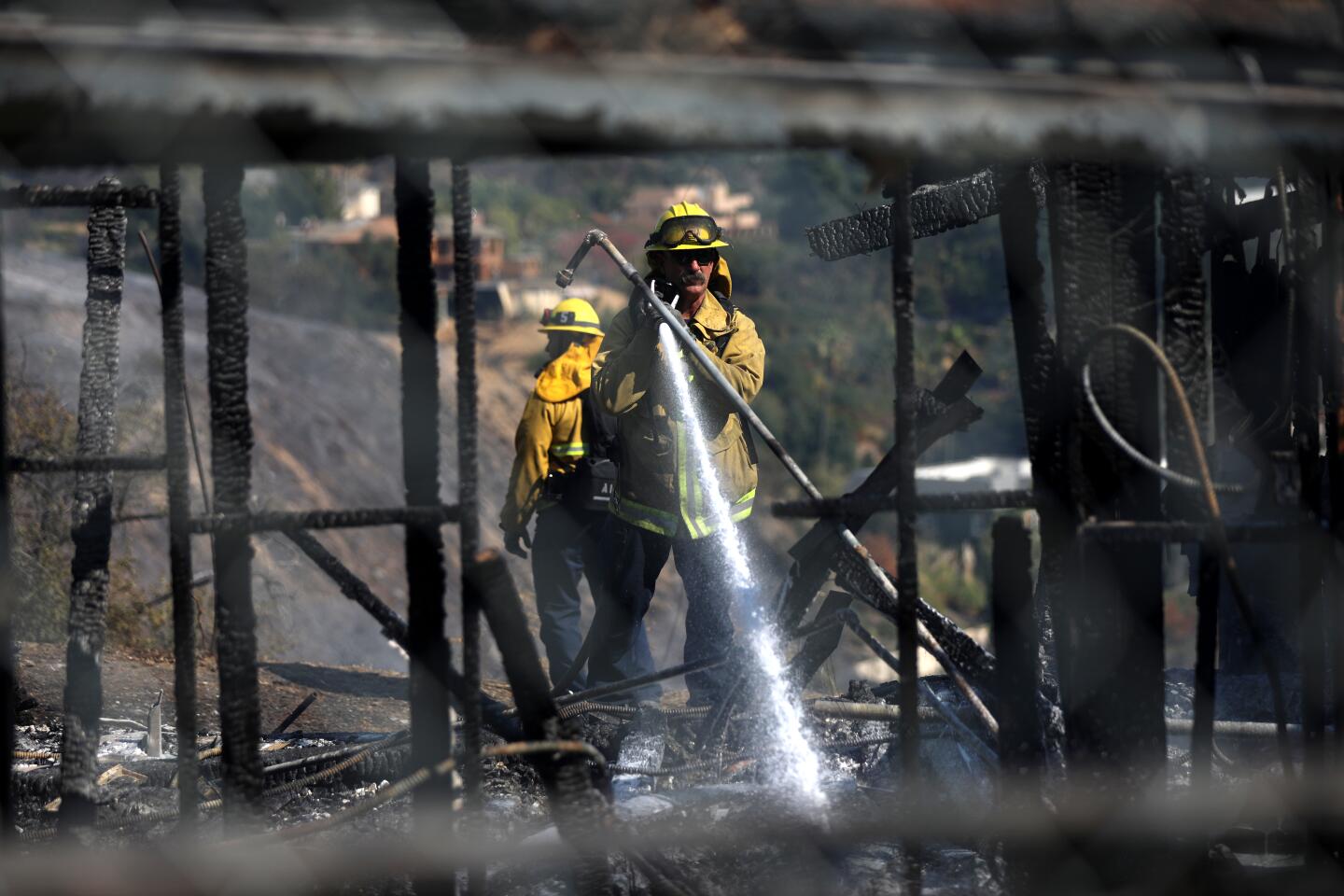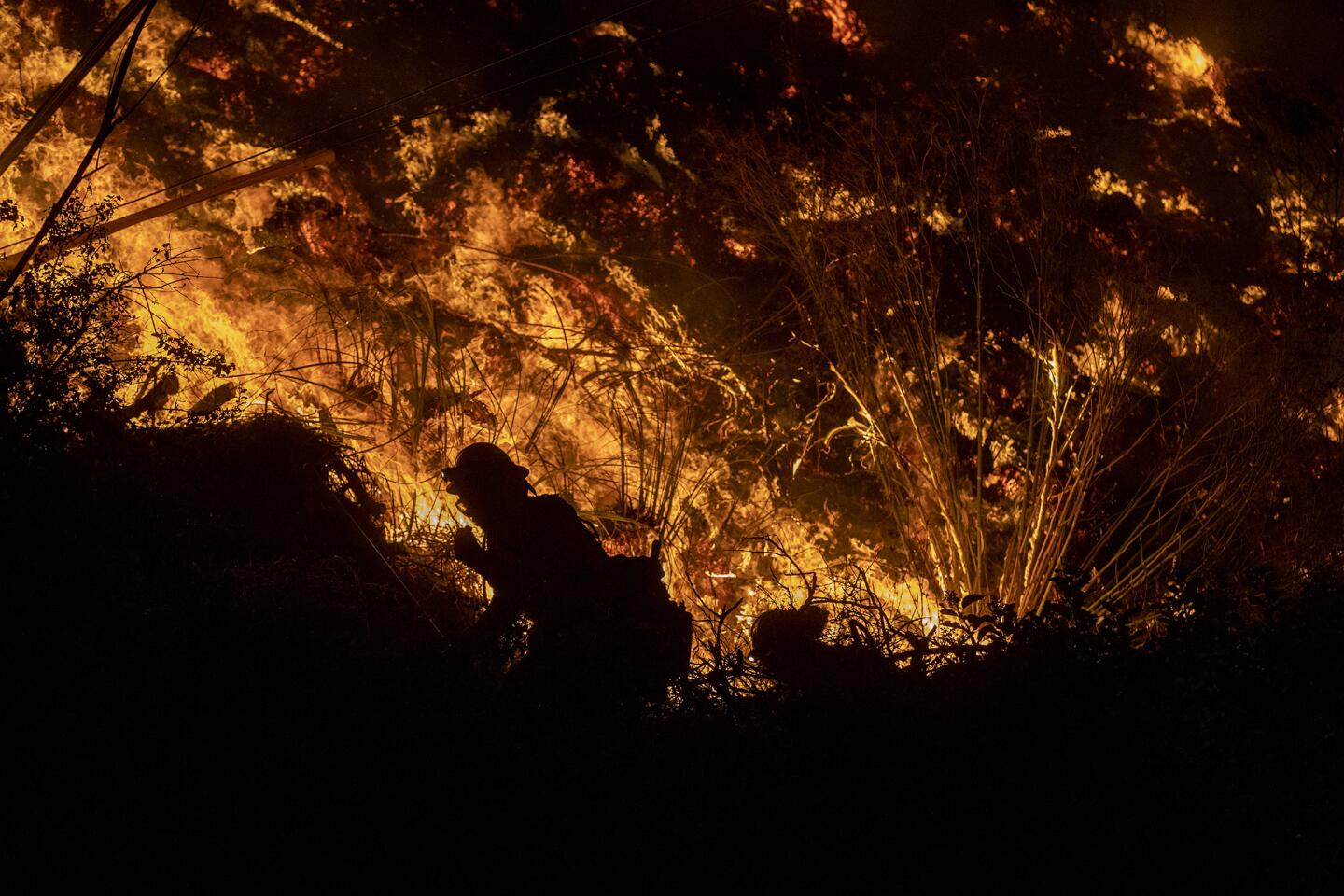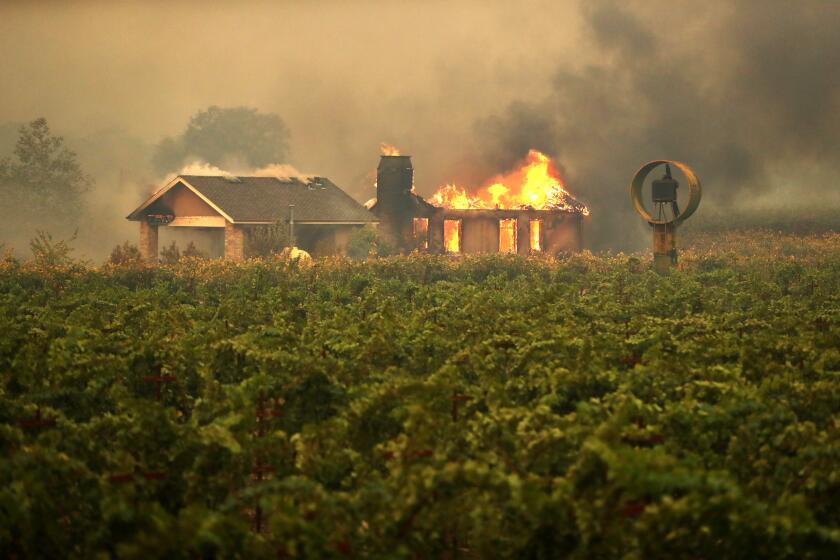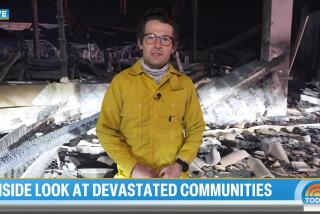Getty fire: Westside residents grab their ‘apocalypse bags’ and race to outrun flames
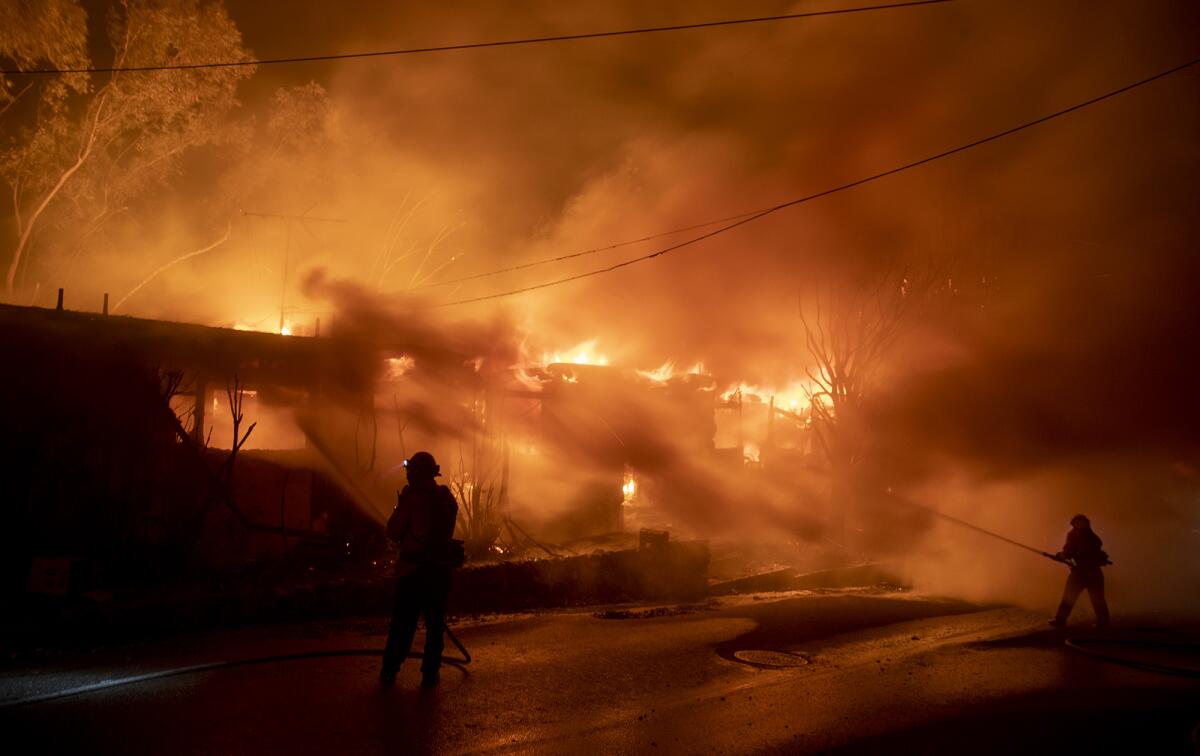
- Share via
Rhonda Taylor got back to her Palisades home around 1 a.m. Monday and was getting ready for bed when she saw images of a fire on the TV. Taylor assumed it was burning somewhere in the Valley, and even if it was closer, she reasoned, the blaze that broke out in the Palisades last week hadn’t prompted an evacuation of her neighborhood. She fell asleep.
Taylor woke around 3 a.m. to her phone ringing and the smell of smoke. Her throat was parched and her head hurt. She answered to a city of Los Angeles phone alert, telling her she needed to leave.
Although she already had what she called her “apocalypse bag” in the car, Taylor was so nervous she grabbed extra toiletries, toothbrushes, clothes and water. She put her Pomeranian, Bu, in his carrier, grabbed a 36-by-24-inch painting of her two children and swaddled it in pillowcases, and loaded her car. As she drove to an evacuation center in Westwood, through smoke so thick it was like a deep fog descending on her neighborhood, Taylor cried, thinking of all the things she hadn’t had the time or the space in her car to gather in the night.
By then, the Getty fire was raging, burning homes and making a run for Brentwood and points west.
Taylor says she’s grown weary of the lingering fear of fire, the possibility that she will need to get up at a moment’s notice and leave her home behind, the worry that sets in when her gas tank hits half-empty.
Taylor loves her house and the views it commands of the ocean. But she wonders if it is worth living, as she puts it, “on the edge of fear.”
Roberta Shintani and her son, Kevin, were also woken at 3 a.m. Their roommate told them the police had come by and said they needed to go. Two years ago, when flames lashed the hillsides above the 405, Roberta and Kevin had prepared to evacuate but ultimately weren’t required to. This time, they had to go.
Roberta gathered up some clothes and her laptop, Kevin grabbed his guitar and, with their two daschund mixes — Mowglie and Baloo — they made their way to an evacuation center in Westwood.
The streets were choked with cars. Debris whipped through the air. The sky, which was glowing orange when they woke up, “went from bright to extremely bright in a very short amount of time,” Kevin said.
It was a surreal scene, Roberta said, seeing the Westside streets jammed with cars, the sky orange, at 3 in the morning.
Kevin noted that Lakers star LeBron James, too, had been displaced — although he had tweeted he was looking for a hotel room well before Kevin and his mother left their home.
“He must have had an inside scoop,” he said.
Robert Lempert was awoken by a neighbor banging on the door of his Palisades home at 3:30 a.m. The Rand Corp. researcher had received several “panicked messages” from his mother-in-law, who lives in a neighborhood under evacuation. Lempert and his wife loaded up their cars with “go bags,” had his mother-in-law come over and waited for the order to evacuate. As of 10 a.m., they were “still in wait-and-see mode.”
Lempert, an expert on climate risk management, says there’s a growing awareness in his Westside neighborhood that these large-scale fires aren’t anomalous. The Getty blaze, and a smaller one in the Palisades last week, are vivid demonstrations of this “new normal,” Lempert said.
“It’s one thing to look at the risk maps and show them to your family,” he said. “It’s another to get a knock on your door at 3 in the morning.”
The wildfires engulfing California this month have burned some of the same areas where other major fires have destroyed thousands of homes in recent years. But no one at the state level has formally proposed robust limits on home building in areas at risk of wildfire, even though a recent poll show voters support such restrictions.
Lempert and his neighbors have taken steps to mitigate a fire’s ability to blow through their streets, chiefly by removing dry brush that can become kindling for firebrands, which he described as “a wind-driven sea of matches.”
For their part, Lempert and his wife have cut down some trees on their property and trimmed others, placed screens over their vents and installed metal skirts beneath their deck to shield it from embers.
“You see it slowly taking place,” Lempert said. “But the question is, are we doing it fast enough?”
Fires have a history of blasting out of control in the lush hills surrounding Danny Cahn’s home. In 1961, when Cahn was a preschooler, residents were forced to flee an inferno that swept through Bel-Air and Brentwood, razing 484 homes.
Life has never quite been the same since, Cahn said, the “big one” roared though, propelled by Santa Ana wind conditions that left a number of L.A.’s rich and famous homeless.
“There’s always a threat hanging in the air around here,” Cahn, 62, a retired film editor, said while snapping photos of helicopters and planes dropping loads of pink retardant and clean, white water on flames less than half a mile away. “I can recall six or seven major fires in my lifetime.”
It happened again early Sunday morning, when Cahn and his wife were awakened by the smell of smoke wafting through a bedroom window.
“We immediately packed up our belongings — and I sent my wife and Great Dane off to stay with relatives,” he said. “I’m ready to go too — but not yet. Right now, we have the best firefighters and air attack crews in the world taking care of things.”
By 1 p.m. Monday, Cahn had taken hundreds of photos amid what had become an almost familiar smoky spectacle: firetrucks, sirens blaring, racing to hot spots along two-lane neighborhood roads and the deafening sounds of aircraft flying just a few hundred yards overhead.
“When the smoke clears and the fires are out,” he said, “it’ll be a wonderful place to live — until the next wildfire.”
More to Read
Sign up for Essential California
The most important California stories and recommendations in your inbox every morning.
You may occasionally receive promotional content from the Los Angeles Times.


